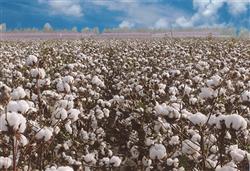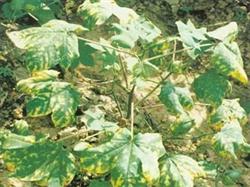Integrated Control techniques of Cotton Diseases and insect pests

In recent years, with the comprehensive cultivation of insect-resistant cotton, cotton aphid, cotton leaf mite, Verticillium wilt and cotton bug bug have become the main diseases and insect pests in cotton field, which seriously affected the improvement of cotton yield and quality. Cotton diseases and insect pests are as follows: first, cotton seedling disease: cotton seedling diseases and insect pests are mainly caused by blight and sudden fall at the seedling stage. Low temperature, heavy rain, continuous cropping and early sowing are the important reasons for the frequent occurrence of cotton seedling disease. At the beginning of cotton seedling root disease, timely use 40% carbendazim glue suspension + new high fat film 800 times solution, 65% Dysen zinc wettable powder + new high fat film 800 times solution or 36% cotton withering wettable powder 10g / mu, spray 15kg cotton seedling stem with water, spray again at intervals of 5 to 7 days. 2. Cotton aphid: the seedling aphid occurs from emergence to budding, and the control begins when the leaf curling rate is more than 30%. During the peak period of cotton aphid damage from mid-June to late July, 10% imidacloprid wettable powder + 800-fold solution of new high-fat film or 15% Jinhao EC + 800-fold solution of new high-fat film can be selected for uniform spraying of stems and leaves. When the aphid occurs in the bud and boll stage, due to the high temperature, we can choose 3% acetamiprid EC 2000 times plus 40% chlorpyrifos 1200 times + new high fat film 800x solution to control aphids and other pests. After the cotton plant is closed, 80% dichlorvos EC + 800 times of new high fat film can be sprayed on cotton ridges in sunny and windless evening, which has a good effect on aphids and can also control cotton red spiders. 3. Cotton leaf mite: it began to appear in the cotton field in early May, when the temperature was lower, the reproduction rate was slower, the number of single leaf mites was less, and the damage of cotton seedlings was lighter. From early June to late July, the temperature rose rapidly and cotton spider mites began to multiply in large numbers, and the damage was rampant in dry years. You can choose 15% trimethoprim EC + 800-fold solution of new high-fat membrane, or 1.8% adriamycin + 800-fold solution of new high-fat membrane for spray control. 4. Cotton blind bug: in recent years, the damage of cotton bug to cotton has increased year by year, and the chemical control period is in the middle and late June, during which the cotton plant is relatively young. In case of heavy rain and high relative humidity in the cotton field, it is beneficial to the harm of cotton bug bug. This period is the key period of control. In cotton bud stage and boll stage, 5% acetamiprid EC + 800 times of new high fat film or 4.5% cypermethrin EC + 800 times of new high fat film can be sprayed to control cotton bollworm at the same time. Cotton bollworm: cotton bollworm is the main pest in cotton bud and boll stage, which usually occurs four generations a year. The cotton is mainly damaged by the second and third generations, and the larvae eat buds, flowers and bolls, and the eaten cotton bolls are easy to rot and fall off or become stiff petals. The method of comprehensive control can be adopted. 1. Physical control: install Jiaduo frequency vibrating insecticidal lamp in cotton concentrated planting area, equipped with one set for every 60 mu, the effect of continuous use is better. two。 Chemical control: you can choose 90% Wanling wettable powder + new high fat film 800x liquid, 4.5% cypermethrin EC + new high fat film 800x liquid or 1.8% averine + new high lipid film 800x solution for stem and leaf spray, spray once every 7 days, spray 2 times 3 times, and spray 20% EC + new high fat film 800x or 20% cyanma EC 1500 times evenly when cleaning up the residue in the later stage. Cotton Fusarium wilt and Verticillium wilt: both are diseases that harm the vascular tissue of cotton, causing discoloration, dryness, shedding and wilting of cotton leaves, and sometimes successively withered, seriously affecting the yield. Can be used in the cotton bud stage with Huanghuangweiling 40 grams per mu of water spray (preferably with irrigation) 3 times 4 times. 7. Beet armyworm (Spodoptera exigua): an omnivorous pest with 4-5 generations a year, serious generation overlap, irregular age, high temperature and drought climate factors and mixed cultivation conditions of many kinds of crops are beneficial to the occurrence of beet armyworm and extensive management. the occurrence of cotton fields with many weeds is more serious. 0.2% methylvitamin salt + 800-fold solution of new high-fat membrane or 25% diflubenzuron suspension + 800-fold solution of new high-fat membrane can be evenly sprayed on cotton plants and field weeds for 2 times for 3 times, and the effect is good.
- Prev

Measures should be taken to prevent seedling disease from cotton sowing to seedling stage
There are more than ten kinds of cotton seedling diseases, such as blight, anthrax, quenching, root rot and so on, which are collectively called cotton seedling disease. The light ones grow slowly, wilt late, and the heavy ones lack seedlings and break ridges, die in pieces, and do great harm. After the occurrence of cotton seedlings, although a series of disease prevention and treatment measures were taken, such as timely release of plastic film cotton, near the root.
- Next

Scientific Control of Cotton Fusarium Wilt and Verticillium Wilt
Fusarium wilt and Verticillium wilt are the main diseases affecting the high yield and efficiency of cotton. It is necessary to correctly identify the symptoms and take relative measures to improve the yield and quality and increase the benefit. First, cotton Fusarium wilt: the disease can occur in the cotyledon stage, the first peak occurs in the budding stage, and the symptoms of Fusarium wilt in the seedling stage are complex and diverse.
Related
- The first cup of black tea in spring, the flavor and history of tea gardens in Kenya, Africa
- The computer can not only choose potatoes, but also grow tea rice. AI will grow winter oolong tea champion.
- It is not only the inflated tea bitten by insects, but also engraved with the four seasons tea in Beipu.
- The Oriental Beauty Tea Festival in Zhuxian County takes the stage at the weekend to experience the plus-size feast of oil tea.
- & quot; Oriental Beauty Tea & Exploration of Emei in Hsinchu, the hometown of quot;
- The new variety of strawberry "Tainong 1" dessert is the first choice with mellow aroma. Crimson gorgeous
- History of Tea in Taiwan: from Wild Inner Mountain to Export Tea Garden
- Two types of Taiwan Oriental Beauty Black Tea won the British three-Star Award for Childhood Tea Xiang Zhang Jiaqi changed from pilot to champion tea maker.
- Banana species and varieties: the planting history of Taiwan Xianren banana and dwarf banana is long, is banana disease resistant?
- Coffee planting Technology: Qianjie Coffee from Seedling to harvesting

